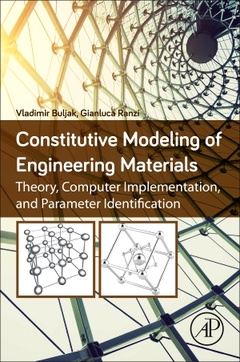Description
Constitutive Modeling of Engineering Materials
Theory, Computer Implementation, and Parameter Identification
Authors: Buljak Vladimir, Ranzi Gianluca
Language: English
Subjects for Constitutive Modeling of Engineering Materials:
Keywords
anisotropic; backward-Euler return algorithm; brittle material; characterization; constitutive equations; constitutive modeling; cost function; deformable body; ductile material; Elastic; elastomers; Elasto-plastic model; equilibrium; finite element modeling; Geometric non-linearity; hyper-elastic model; incompressibility; indentation test; inverse analysis; isotropic; large deformations; material characterization; Mechanical characterization; mesh locking; numerical implementation; objective function; optimization; orthotropic; parameter identification; Polymers; pseudoelasticity; reduced integration; shape memory alloy; Shape memory effect; standard test; strain; strain energy density function; stress; stress return algorithm; stress–strain relationship; Structural analysis; superelasticity; tangent stiffness matrix; thermoelastic; thermoplastics; thermosetting polymers; total Lagrangian iterative procedure; visco-elastic; von Mises plasticity model
193.44 €
In Print (Delivery period: 14 days).
Add to cart328 p. · 15x22.8 cm · Paperback
Description
/li>Contents
/li>Readership
/li>Biography
/li>Comment
/li>
Constitutive Modeling of Engineering Materials provides an extensive theoretical overview of elastic, plastic, damage, and fracture models, giving readers the foundational knowledge needed to successfully apply them to and solve common engineering material problems. Particular attention is given to inverse analysis, parameter identification, and the numerical implementation of models with the finite element method. Application in practice is discussed in detail, showing examples of working computer programs for simple constitutive behaviors. Examples explore the important components of material modeling which form the building blocks of any complex constitutive behavior.
1. Introduction2. Calibration of constitutive models3. Inverse analysis4. Elastic constitutive models5. Constitutive models for inelastic deformation—introduction6. Numerical implementation of constitutive models with large deformation7. Metals8. Polymers9. Shape memory alloys
Researchers, MSc students, and engineers with an interest in continuum modeling and solid mechanics. Will appeal to people with backgrounds in mechanical engineering or materials science
Gianluca Ranzi is a Professor in the School of Civil Engineering and Director of the Centre for Advanced Structural Engineering at The University of Sydney. His research interests fall in the fields of structural engineering, architectural science, building energy management and power demand side management, and heritage conservation.
- Addresses complex behaviors in a wide range of materials, from polymers, to metals and shape memory alloys
- Covers constitutive models with both small and large deformations
- Provides detailed examples of computer implementations for material models




